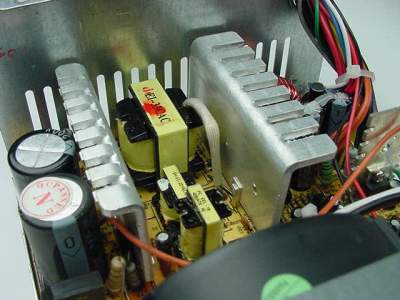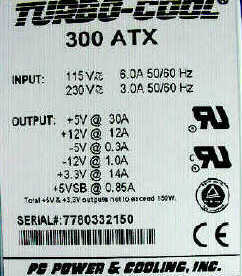Switcher Technology
Prior to 1980 or so, power supplies tended to be heavy and bulky. They used large, heavy transformers and huge capacitors (some as large as soda cans) to convert line voltage at 120 volts and 60 hertz into 5 volts and 12 volts DC.
The switching power supplies used today are much smaller and lighter. They convert the 60-Hertz (Hz, or cycles per second) current to a much higher frequency , meaning more cycles per second. This conversion enables a small, lightweight transformer in the power supply to do the actual voltage step-down from 110 volts (or 220 in certain countries) to the voltage needed by the particular computer component. The higher-frequency AC current provided by a switcher supply is also easier to rectify and filter compared to the original 60-Hz AC line voltage, reducing the variances in voltage for the sensitive electronic components in the computer.
 In this photo you can see three small transformers (yellow) in the center. To the left are two cylindrical capacitors. The large finned pieces of aluminum are heat sinks. The left heat sink has transistors attached to it. These are the transistors in charge of doing the switching -- they provide high-frequency power to the transformers. Attached to the right heat sink are diodes that rectify AC signals and turn them into DC signals. |
A switcher power supply draws only the power it needs from the AC line. The typical voltages and current provided by a power supply are shown on the label on a power supply.
 Personal computer power supply label. VSB is the standby voltage provided to the power switch. |
Switcher technology is also used to make AC from DC, as found in many of the automobile power inverters used to run AC appliances in an automobile and in uninterruptible power supplies . Switcher technology in automotive power inverters changes the direct current from the auto battery into alternating current. The transformer uses alternating current to make the transformer in the inverter step the voltage up to that of household appliances (120 VAC).
Back to How It Works
› Introduction to How PC Power Supplies Work
› Switcher Technology
› Power Supply Standardization
› Power Supply Wattage
› Power Supply Problems
› Power Supply Improvements